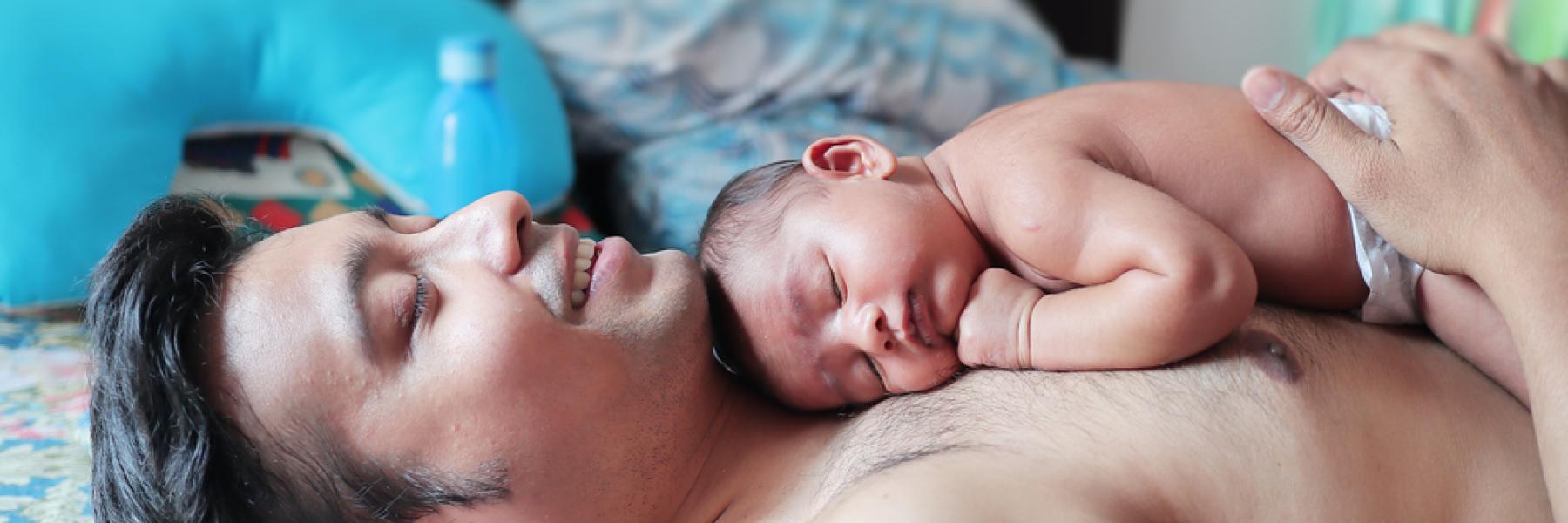
Skin to skin contact with your baby
Skin to skin means cuddling your baby with your skin against theirs. Before your baby is born, they are warm, comforted by the sound of your heartbeat, and have a steady supply of nutrients from your placenta. The transition to being outside in the world can be overwhelming for your baby, that's why skin to skin has many benefits.
Skin to skin contact with your baby is best started as soon as your baby is born and can go for at least an hour or until the first feed All babies can benefit from skin to skin, whether they are born vaginally or by caesarean section and whether you are choosing to breastfeed or not.
It has great benefit even if it is delayed from immediately after birth. Both mother and baby can benefit from regular skin to skin cuddles for the first few days or weeks of your baby’s life.
Unwell babies that are cared for in the Neonatal Unit also benefit from skin to skin. Providing skin to skin for your baby in the first few months if they are unwell is sometimes called ‘kangaroo care’.
Skin to skin can happen as often as you like and for as long as you like. There are also benefits for your partner if they would like to do skin to skin with your baby.
Benefits of skin-to-skin contact:
- Helps you to bond with your baby
- Comforts and calms your baby, they feel safe with you
- Calms your baby's heart rate and breathing
- Helps your baby to learn how to breastfeed
- Helps your body release hormones that support breastfeeding and motherhood
- Increases your milk supply
- Helps you deliver your placenta quicker
- Reduces postpartum bleeding
- Keeps your baby's temperature normal
- Gives your baby's immune system a great start
- Can reduce maternal anxiety and lower your chance of postnatal depression
- Your partner can do skin to skin with baby after the first feed to help them bond with your baby. They can do it regularly in the first few months of your baby's life. It has also been shown to improve partners' stress levels in early parenting
Planning for skin-to-skin contact after a caesarean section:
Some things you can do if you are planning skin to skin after a caesarean:
- Let the midwives know you will want to stay skin to skin
- Ask your midwife to help support the first breastfeed as soon as possible after birth
- Your partner can help you do skin to skin if you are unwell or recovering from a caesarean section
- have your partner stay with you while you are recovering from a caesarean section to help with the baby
Benefits of skin-to-skin contact for unwell babies (Kangaroo care):
- Helps them to be more relaxed and less stressed
- Keeps their temperature normal
- Keeps their breathing regular and increases oxygen levels
- Reduces the amount of energy they are using
- Assists their immune system
- Helps them grow and put on weight
- Improves the parents' relationship with the baby
Want more information? Check out these links below:
- Preparing the Nest (Video): Preparing the Nest: The first hour - skin-to-skin time with your baby
- Australian Breastfeeding Association: Skin-to-skin contact | Australian Breastfeeding Association
- Miracle Babies (Kangaroo Care): Kangaroo Care - Miracle Babies
- SWSLHD Skin-to-Skin contact: https://swslhd-intranet.sswahs.nsw.gov.au/swslhd/maternity/content/pdf/Building/English.pdf
- Breastfeeding Aboriginal Families Resrouces (Ngaminjang Dhanama Dyalgala): https://swslhd-intranet.sswahs.nsw.gov.au/swslhd/maternity/BreastfeedingReclaimingourTraditionResources.html
References:
-
Karimi FZ, Sadeghi R, Maleki-Saghooni N, Khadivzadeh T. The effect of mother-infant skin to skin contact on success and duration of first breastfeeding: A systematic review and meta-analysis. Taiwan J Obstet Gynecol. 2019; 58(1): 1-9.
-
Moore, E.R, Bergman, N. Anderson, G.C and N. Medley (2016) Early skin to skin contact for mothers and their healthy newborn babies. Cochrane Database of Systematic Reviews https://doi.org/10.1002/14651858.CD003519.pub4
-
Stevens, J., Schmied, V., Burns, E. and Dahlen, H., 2014. Immediate or early skin‐to‐skin contact after a Caesarean section: a review of the literature. Maternal & child nutrition, 10(4), pp.456-473.
-
Widström, A.M., Brimdyr, K., Svensson, K., Cadwell, K. and Nissen, E., 2019. Skin‐to‐skin contact the first hour after birth, underlying implications and clinical practice. Acta Paediatrica, 108(7), pp.1192-1204
-
World Health Organization. (2022). WHO recommendations for care of the preterm or low birth weight infant. Licence: CC BY-NC-SA 3.0 IGO. https://www.who.int/publications/i/item/9789240058262
Related Topics

Labour and the experience of pain during labour are different for each person.

A vaginal birth is usually the safest option for you and your baby if there is no serious issue in pregnancy and

A caesarean section is a surgical operation in which your baby is born through a cut in your abdomen and uterus.

